Rising high in the northeast of Italy, the Dolomites are a seemingly impenetrable mountain range that has long inspired travelers and intrepid adventurers seeking new hiking and climbing challenges.
Part of the wider Eastern Alps Range that cuts across Europe, the Dolomites are recognized as a UNESCO World Heritage Site for their beauty and importance.
These tall mountains, with their snow-capped peaks and dramatic passes, are perfect for hiking.
One of the best Dolomites hiking routes to tackle is the Alta Via 1, a multi-day, long-distance hiking route.
This route takes you through stunning alpine scenery, past glorious freshwater lakes, and through charming Tyrolean villages.
It’s tough, it’s uphill, but it’s a great Dolomites hiking experience. To help you plan your trip, here’s our guide to planning and hiking the Alta Via 1.
Don’t leave home without: Lonely Planet Italy (Travel Guide)
Dolomites Hiking: Alta Via 1 Guide
Table of Contents
What is the Alta Via 1?

In the Dolomites, an Alta Via is essentially a High Route. These are long-distance trails that pass through the alpine regions and through the mountains.
They are distinct from Via Ferrata, which requires technical climbing gear.
In the Dolomites, there are 8 Alta Via systems that form a network of hiking trails across the mountains.
The Alta Via 1 is often seen as the most spectacular, and the easiest to complete, although it’s definitely a challenge!
The Alta Via 1 is a Dolomites hiking route that stretches for 120 kilometers and takes at least 10 days to complete.
It’s found in the South Tyrol region, and the traditional starting point of the hike is Lago di Braies, which is also known in the local German dialects as Pragser Wildsee.
The endpoint is usually the town of Belluno.
How to Reach the Start and End Points of the Alta Via 1

The Alta Via 1 is not a Dolomites hiking route that’s circular, and you will of course start and end in different places.
This means that you need to arrange your logistics beforehand, and plan your timing etc. to ensure you can arrive and depart smoothly, particularly if you have flights booked.
Taking a car isn’t exactly practical, although you could arrange transfers if you’re not on a budget.
Or if you have some very good friends willing to hang around and pick you up in the region!
This is a rural area, and while most hikers will get to the trailhead using public transport, depending on where you are arriving from this can take several changes of bus and train.
Be sure to factor in extra time for the trip as a whole so you aren’t rushing around before you even begin the hike.
The closest airport to the Alta Via 1 start point at Pragser Wildsee will be Venice. It also offers excellent connections across both Italy and the rest of Europe.
There are budget flights to most major European cities, and scheduled flights further afield too.
From Venice, you can catch local transport to the start of the trailhead, but be prepared to change a few times.
From Belluno, on the return, you can again catch public transport back to Venice.
If you have more time to explore, be sure to plan some extra time to explore Venice. There are some amazing things to do and see in the famed city.
Best Time to Hike the Alta Via 1

With multiple peaks that rise above 3000 meters, Dolomites hiking is a very seasonal activity.
This is relatively high altitude trekking, and the region has an unpredictable weather system.
Due to its unique geology, it’s also particularly prone to avalanches and landslides, particularly in the spring.
For this reason, it’s important to only hike unsupported during the main Dolomites hiking season.
The season usually runs from the end of June to the end of September. This is when the Alta Via 1 is mostly free from snow, although you never know exactly when this will be in the Dolomites.
In winter, the Dolomites turn into one huge ski resort, and though hiking is put on hold, you can enjoy snow trekking with guides and mountaineering.
In spring, there’s a real danger of avalanches, while in autumn, you can face fierce snowstorms.
Facts About the Alta Via 1 Hike

- Alta Via 1 is the first of 8 different long-distance hiking routes in the Dolomites
- Alta Via 1 is 120 kilometers in length
- The trail starts in Pragser Wildsee and ends in Belluno
- This Dolomites hiking route is marked by distinctive Blue Triangles which act as waymarkers
- It’s illegal to wild camp, but there are Rifugios available at the end of each section for sleeping and eating, which means you don’t need to be self-supported
- Takes on average 10 days to complete, with a rough altitude gain each day of 800 meters up and down
- The highest point on Alta Via 1 is 2700 meters high
Guided vs Unguided

This is a long-distance hiking route, and while it can be very up and down each way, the route itself is not technical and no specialist equipment or training is needed.
You will need experience with shorter multi-day hikes and hiking in alpine terrain at altitude.
If you are fit and ready then this is a Dolomites hiking route that can be tackled unguided by most.
Alta Via 1 is always the busiest trail in the Dolomites because it’s the easiest and most popular hiking route.
The route is well marked, and there are lots of other hikers heading the same way, so if you stick to the trail and get in trouble, then you won’t have trouble finding help.
It’s always wise to take a map and a cell phone though, just in case.
During the hiking season, there are lots of specialist tour companies offering private and group hikes along the Alta Via 1.
While not necessary, if you are inexperienced or nervous, then joining a tour can make things a lot easier.
Equally, if you are on your own, it can be nice to join a group tour to have some hiking partners, although you will also meet plenty of other hikers along the way, and in the Rifugios.
If you’re interested in learning more about the local nature or geology, or the history of the Dolomites, then joining with a hiking tour can be a great way to find out more.
Mountain Rifugios and Equipment

For anyone attempting the Alta Via 1, it’s important to reinforce the fact that wild camping is technically not allowed along the trails and you can incur hefty fines if you are caught.
This isn’t exactly wilderness so you can expect to get into trouble if you’re planning on camping out.
Along the route, spread out evenly across the Alta Via 1, are the Dolomite’s famous Mountain Rifugios, or mountain refuges.
This is where you will be spending your nights while on the trail, and it means that you can hike unsupported, and essentially only carry a day pack and minimal equipment to make things easier.
Mountain Rifugios are evenly spread, and a hike on the Alta Via 1 essentially becomes a hike from one refuge to the next each day.
The Rifugios provide food and lodging, however, you will need to bring your own sleeping bag to use.
Rifugios can provide all your meals for you, however, you can also bring along your own food to cook if you want to save money, as the Rifugios aren’t exactly cheap.
The beds can also get booked out in advance, as you can reserve them online. This is advisable if you want a bed for the night.
While they aren’t allowed to turn anyone away, they only have a limited number of beds in the rooms, so if it’s full you will have to bed down on the floor.
The Rifugios also sell supplies, but again, things can be expensive.
You can fill up your water bottles from the mountain streams, and you can bring purification tablets or sterilization pens if you want to be super hygienic.
Make sure you have plenty of cash because most Rifugios only accept hard cash.
You will need solid hiking boots and a comfortable hiking pack, as well as a head torch and rain gear as a minimum.
Being prepared while hiking is important. To ensure you are properly prepared for your hike, check out: 40 Hiking Essentials: The Ultimate Hiking Packing List
Highlights of the Alta Via 1 Hike

The hike starts at the beautiful alpine lake of Pragser Wildsee, which is a highlight of the trip, but by no means the last beautiful spot.
There’s a lot more waiting as you progress towards Belluno, which is itself a charming town to discover at the end of the route.
You’ll see vast mountain landscapes on every turn of the trail, and the Dolomites are particularly noted for their rocky nature and many standalone rock formations.
An iconic rock formation that’s usually seen around day 3 is the Cinque Torri, a dramatic collection of five rocks that rise abruptly from the ground.
At 2700 meters in height Monte Lagazuoi is the highest peak on the Alta Via 1, and you can even find a lovely Rifugio at the summit.
You’ll also find that the Dolomites was a fierce battleground during World War I, between Italian and Austrian forces.
There are the remains of many bunkers, tunnels, and battles all along the route, which can be fascinating sights for anyone interested in the local history of the mountains.
Dolomites Hiking Resources
While hiking in the Dolomites isn’t easy, it is spectacular. The hardest part of your trip will be planning and dealing with logistics.
Booking the rifugios ahead of time is not an easy task, as most require that you call them, rather than be able to book online.
This is inconvenient and can be intimidating, not to mention expensive with the long-distance fees.
Due to this, we decided to use a service for planning our Dolomites hiking trip on the Alta Via 1.
The company we used for this is called MONT Trekking. They specialize in Alpine trekking and hiking trips throughout the alps.
They have relationships with the hotels and rifugios in the region and along the Alta Via 1 and handle all the logistics in arranging these for you.
We selected the self-guided option and then let them know the number of days we wanted. We provided our arrival date, where we wanted to start and they took it from there.
In doing this, they arranged all of the rifugios for us along the trail, provided us with maps and a day by day plan of what we could expect on the trail.
We also opted for the meal plans, so this meant we had dinner and breakfast included in our rifugio stays too.
This took all the worry of planning away and actually made the trail very enjoyable. We knew where to go, what to expect and that we had a nice comfy bed on the other end of it.
Additionally, we also purchased and carried the Cicerone guide Trekking in the Dolomites.
This book covers the Alta Via 1 and Alta Via 2, providing day by day breakdowns of the trail.
It also provides information for planning, packing and what to expect from the rifugios.
| Recommended Tours | ||
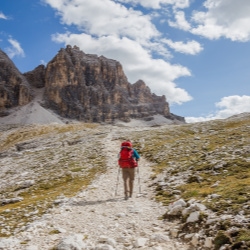 | 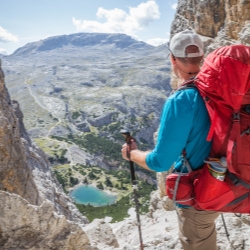 | 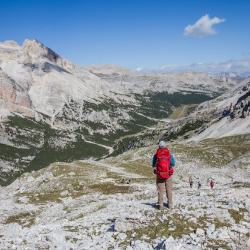 |
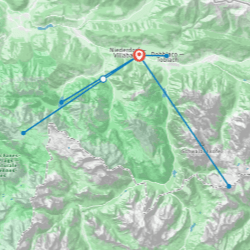 | 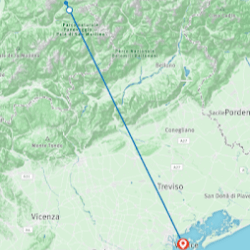 | 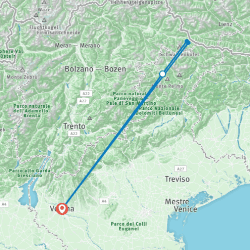 |
| Classic Dolomites 8 Days Villabassa to Villabassa Experienced English-speaking guide Meals & Accommodations 12-16 Group Size | Highlights of the Dolomites 8 Days Venice to Venice Experienced English-speaking guide Meals & Accommodations 12-16 Group Size | Dolomite Explorer 12 Days Verona to Verona Experienced English-speaking guide Meals & Accommodations 12-16 Group Size |
| Check Price | Check Price | Check Price |
You might also like:
- 5 of the Best Places to Visit in Italy
- Ultimate 10 Day Italy Itinerary
- The Perfect Tuscany Road Trip Itinerary
- 15 Easy & Amazing Day Trips From Venice
- Where to Stay in Venice: Best Districts & Hotels
- The Ultimate 3 Days in Rome Itinerary
- Rome to Pompeii: The Best Way to Make it Happen
- Ultimate 3 Days in Florence Itinerary

